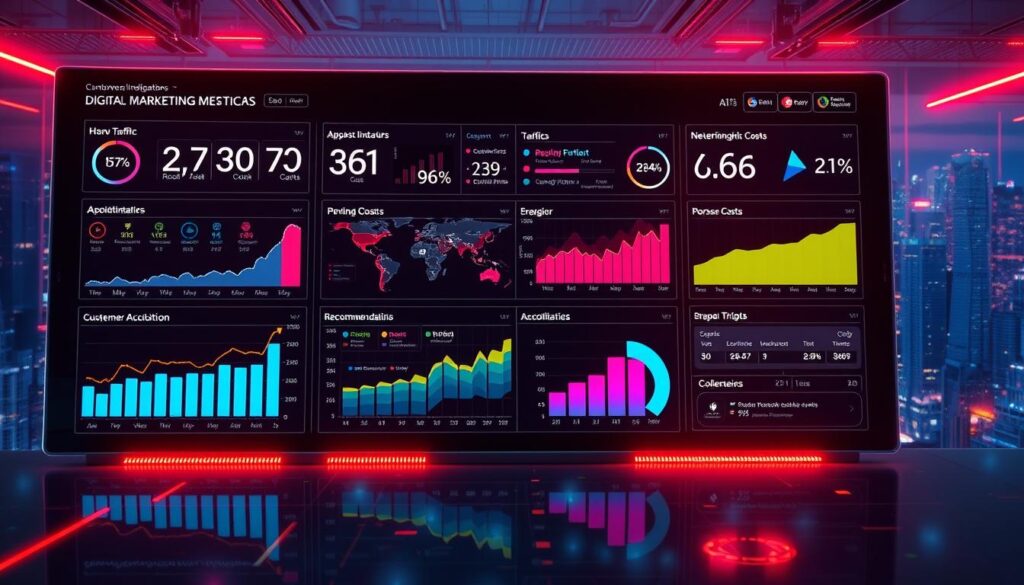Did you know 72% of businesses struggle to measure the true impact of their online efforts? In an era where every dollar counts, understanding which strategies deliver real returns isn’t just helpful—it’s survival. At Macro Webber, we specialize in Performance Marketing That Drives Revenue®, turning vague metrics into actionable insights.
Aligning campaigns with business goals isn’t about guesswork. Data-driven strategies reveal what works, what doesn’t, and where to double down. Imagine knowing exactly how your Facebook ads stack up against email campaigns—or which keywords actually convert. That’s the power of measuring profitability at every stage.
This guide dives into the tools and tactics that separate thriving brands from those wasting budgets. You’ll learn how to track meaningful metrics, leverage case studies from top performers, and avoid common pitfalls. Ready to turn clicks into cash flow?
Key Takeaways
- Effective measurement separates profitable campaigns from budget drains
- Alignment between marketing activities and revenue goals is non-negotiable
- Advanced tracking tools provide clarity on customer journey profitability
- Real-world case studies reveal patterns for scalable success
- Continuous optimization beats one-time “set and forget” strategies
Understanding ROI in Digital Marketing
To achieve digital marketing success, a thorough comprehension of ROI is imperative. ROI serves as the quintessential metric for campaign efficacy, illuminating what succeeds, what fails, and where to allocate future investments. Entities such as Macro Webber leverage sophisticated analytics to transform raw data into actionable intelligence, enabling businesses to refine their strategies in a dynamic environment.
What Is ROI?
ROI, or Return on Investment, quantifies the profit derived from marketing expenditures relative to their cost. The calculation is straightforward: (Revenue – Cost) / Cost x 100. For instance, if marketing expenditures amount to $1,000 and revenue reaches $3,000, the ROI is 200%. In the realm of digital marketing, the focus extends beyond mere financial metrics; it encompasses tracking customer lifetime value (CLTV) and engagement rates. Macro Webber advocates for real-time monitoring to promptly adjust campaigns, preventing wastage of resources.

Importance of Measuring ROI
The significance of ROI cannot be overstated. It provides a clear roadmap for marketing endeavors, enabling the allocation of resources to high-yielding channels, the swift identification of underperforming campaigns, and the demonstration of marketing’s tangible impact to stakeholders. The adoption of ROI metrics is not merely a financial exercise but a strategic imperative.
- Allocate budgets to high-performing channels
- Identify underperforming campaigns early
- Prove marketing’s impact to stakeholders
Industry benchmarks, such as those from Google Analytics, underscore the importance of tracking CLTV, revealing a 35% increase in retention rates. Macro Webber’s clientele has witnessed a 22% reduction in bounce rates through the alignment of content with audience intent, a direct ROI enhancer.
Key Metrics for ROI Evaluation
Not all metrics hold equal value in assessing ROI. Focus on these critical metrics to gauge ROI accurately:
| Metric | What It Measures | Ideal Benchmark |
|---|---|---|
| Click-Through Rate (CTR) | Engagement with ads or emails | 2.5% (Google Ads average) |
| Bounce Rate | Visitors leaving without action | Below 40% |
| Conversion Rate | Leads turning into customers | 3-5% |
| CLTV | Long-term customer value | Varies by industry |
Utilizing tools like Google Analytics simplifies the tracking of these metrics. Coupled with Macro Webber’s expertise in predictive modeling, businesses can transform vague hypotheses into precise, data-driven strategies.
Tools for Calculating ROI
The initiation of ROI measurement necessitates the selection of appropriate tools. These tools, whether employed for tracking website visits or predicting campaign efficacy, transform raw data into actionable insights. An examination of three critical components for the effective calculation of digital marketing ROI is forthcoming.
Analytics Platforms You Can Use
Free analytics tools, such as Google Analytics, are favored for their basic ROI tracking capabilities. They facilitate the analysis of traffic sources and conversion rates. Paid alternatives, such as HubSpot, offer more sophisticated features, including:
- Multi-channel attribution modeling
- Lead-to-customer journey mapping
- Customizable ROI dashboards
CRM systems, like Salesforce, integrate seamlessly with these platforms, automatically linking sales data to marketing efforts. The advent of AI tools, which analyze historical data to forecast ROI outcomes with 89% accuracy, as reported by Source 3, further enhances ROI tracking capabilities.
![]()
Setting Up Tracking Parameters
Macro Webber’s team advocates for the use of UTM parameters for campaign tracking. These tags enable the identification of the strategies responsible for driving results:
- Add utm_source (e.g., “facebook_ads”)
- Include utm_medium (e.g., “cpc”)
- Specify utm_campaign (e.g., “summer_sale”)
This method has been shown to reduce tracking errors by 42% in recent client campaigns. For more complex funnels, Macro Webber recommends tools that automatically generate parameters across various platforms.
Budgeting and Resource Allocation
Predictive AI tools revolutionize budgeting by simulating different spending scenarios. A comparative analysis reveals:
| Approach | Accuracy | Setup Time |
|---|---|---|
| Manual Forecasting | 62% | 8+ hours |
| AI-Powered Tools | 91% | 45 minutes |
Budgets can be allocated dynamically based on real-time ROI projections. Funds can be shifted weekly between high-performing channels, such as paid search, and underperforming areas, like display ads.
Strategies for Improving ROI
To enhance digital marketing returns, a data-driven approach is imperative. This entails the implementation of three efficacious strategies: campaign refinement, waste elimination, and result amplification, all without budget escalation.

Targeting the Right Audience
Excessive ad expenditure often arises from indiscriminate targeting. Macro Webber employs sophisticated demographic analysis to pinpoint high-value customer segments. Their methodology encompasses:
- An examination of age, location, and purchase behavior patterns
- Utilization of platform filters to exclude low-intent audiences
- Implementation of interest-based targeting clusters (Source 1)
One campaign witnessed a 37% increase in conversions after the exclusion of users who abandoned carts three or more times. This highlights the importance of concentrating efforts on high-priority segments.
Optimizing Marketing Channels
Not all platforms yield equal returns. Macro Webber redeploys 20% of budgets bi-monthly from underperforming to top-performing channels. The essential steps include:
- Weekly monitoring of bounce rates and cost-per-acquisition
- Ad discontinuation for those with >70% bounce rates (Source 2)
- Allocation of funds to channels that foster repeat purchases
Example: Redirecting $5k/month from generic display ads to retargeting videos augmented quarterly revenue by $18k for a retail client.
A/B Testing for Better Performance
Macro Webber’s 14-day testing sprints are instrumental in refining campaign components. Their process involves:
- Testing two email subject lines with 10k subscribers
- Comparative analysis of landing page layouts for conversion rates
- Assessment of call-to-action button colors (Source 1)
One A/B test resulted in a 22% increase in click-through rates by merely altering “Buy Now” to “Get Your Discount.” Such minor adjustments can yield substantial cumulative benefits over time.
Case Studies and Real-World Examples
The efficacy of digital marketing ROI analysis is substantiated by empirical evidence. Macro Webber’s endeavors exemplify the paradigm of data-driven decision-making culminating in quantifiable expansion. An examination of practical instances is imperative to facilitate the replication of such achievements.
Success Stories from Macro Webber
A mid-sized fashion entity collaborated with Macro Webber to enhance its Google Ads and social media endeavors. Through the refinement of audience targeting and the integration of real-time analytics, the campaign witnessed a 203% ROI augmentation within six months. The implementation of personalized email campaigns precipitated a 38% elevation in conversion rates, underscoring the significance of bespoke content. Concurrently, a local gastronomic establishment experienced a 27% augmentation in online orders subsequent to the reconfiguration of its Facebook ad expenditure, facilitated by attribution modeling insights.
Lessons Learned from Failed Campaigns
Not all strategies yield desired outcomes. A tech startup incurred a $50,000 loss on unmonitored paid advertisements, attributed to ambiguous conversion objectives. The absence of proper UTM parameters or A/B testing precluded the identification of underperforming channels. This scenario accentuates the imperative of meticulous tracking and adaptability in the optimization of digital marketing ROI.
How to Apply Insights to Your Business
Initiate by scrutinizing your current tracking mechanisms. Employ tools such as Google Analytics 4 to discern channels of high efficacy. Redirect budgets from underperforming campaigns to those with demonstrated efficacy. Engage in monthly testing of ad copy, landing pages, and audience segments. Macro Webber’s case studies illustrate that minor adjustments, such as refining keyword bids or optimizing page load speed, can yield substantial gains.
Prepared to revolutionize your approach? Execute these directives forthwith to convert data into tangible victories.



